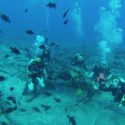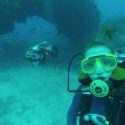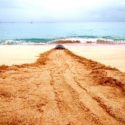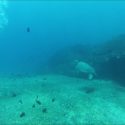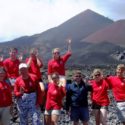Atlantic Endeavour was a SCUBA diving adventurous training expedition to Ascension Island in the Mid-Atlantic Ocean. The goal was to develop individual courage and leadership and to provide BSAC training for six prospective ocean divers, two sports divers, one dive leader and one advanced diver, including boat handling skills for the latter two. This was achieved through controlled exposure to risk in a challenging tropical environment, developing divers’ knowledge, skills and proficiency in dive management.
The expedition was supervised and managed by two SADS, Sqn Ldr Kane and Flt Lt Istance. The ocean divers successfully completed their courses, whilst the other attendees progressed towards completion of their own qualifications. Interspersed amongst the drills of the courses, the divers took advantage of the tropical environment with exceptional visibility, investigating the abundant animal life, ship wrecks and sub-aqueous volcanic structures. The team quickly began to gel and work as one and all had a thoroughly enjoyable two weeks.
In preparation for the open water activities, there were several lectures presented to the ocean divers by the dive leader qualified student, Alison Davies, which was accompanied by pool sessions at RAF Halton. The remainder of the theoretical lessons and tests were conducted in the evenings of the expedition following daily debriefings on the day’s activities through which expedition members reflected and learnt.
The expedition departed Brize Norton for Ascension Island on 16th March 2014, arriving the following morning on the Voyager aircraft. Having moved into the accommodation on Travellers’ Hill, training began that very afternoon, with a shore dive from Guano Jetty in English Bay. Unfortunately, there was an issue with vehicle acquisition, so the first few days required several runs each dive from the dive centre to the jetty to transport equipment and personnel in one Land Rover. This set the tone for efficiency and teamwork for the remainder of the expedition. Hence, when a pick up truck was made available, the team found themselves very competent at organisation, discovering that a diving serial could be executed swiftly and with the minimum of fuss.
For the remainder of dives, a small Ferry RIB was used between jetty and two large RIB’s, which carried six divers plus equipment each to the various dive locations on the North West side of the island. There were a few engine problems during the expedition, which were eventually overcome by the expedition leaders. Safety equipment, cylinders and a compressor were provided at the RAF Sub-aqua Association dive centre on Ascension. There were in total 201 dives, with 7911 minutes underwater.
With regards to safety, there were many considerations. The low obliquity to the sun during hours of diving, combined with air temperatures approximating 30 degrees posed the danger of sun burn, requiring reapplications of UV protection on the water and dehydration, which increases the risk of decompression illness, which was the primary concern for dive safety. The island itself has no recompression chamber, and the nearest is many hours away by air, so avoiding decompression illness was critical. To minimise the risk, the divers used a 34% nitrox mix, whilst calculating tissue nitrogen gassing as though it were air, and ensured there was an ample supply of water whilst on the boat, personal and communal.
The sea conditions were excellent throughout the trip, and the ocean swell did not reach levels which prevented diving operations. During dives, this made it possible to swim through short tunnels and arches, for example, at Eddie’s gullies. As the first diving expedition to the island this year, it landed concurrently with the endangered green turtle nesting season, and all divers were lucky enough to approach resting turtles underwater on at least one occasion. Other notable diving experiences were porcupine fish, prevalent moray eels (of different varieties), octopuses, cowfish and a large barracuda! There were plenty of historical anthropogenic curiosities to be found: there were dives to the wreck of the Derby, the Soudan and the recently discovered Yorkshire Chariots; four large wheeled metal chassis which probably carried artillery pieces.
The air passage home was delayed by twenty four hours due to adverse weather conditions, which afforded an extra day’s diving that made up for the one lost when the boat was replaced. Finally there were sightings of dolphins, on the way to the dive site, chasing after an impressive school of flying fish in the waters near Georgetown.
With all expedition objectives completed without incident, those involved gained a thorough understanding of the need for planning, teamwork and management of all assets. The expedition returned to the UK much better prepared for future challenges, and would like to thank the Ulysses Trust for their support, without which the expedition would not have been possible.

